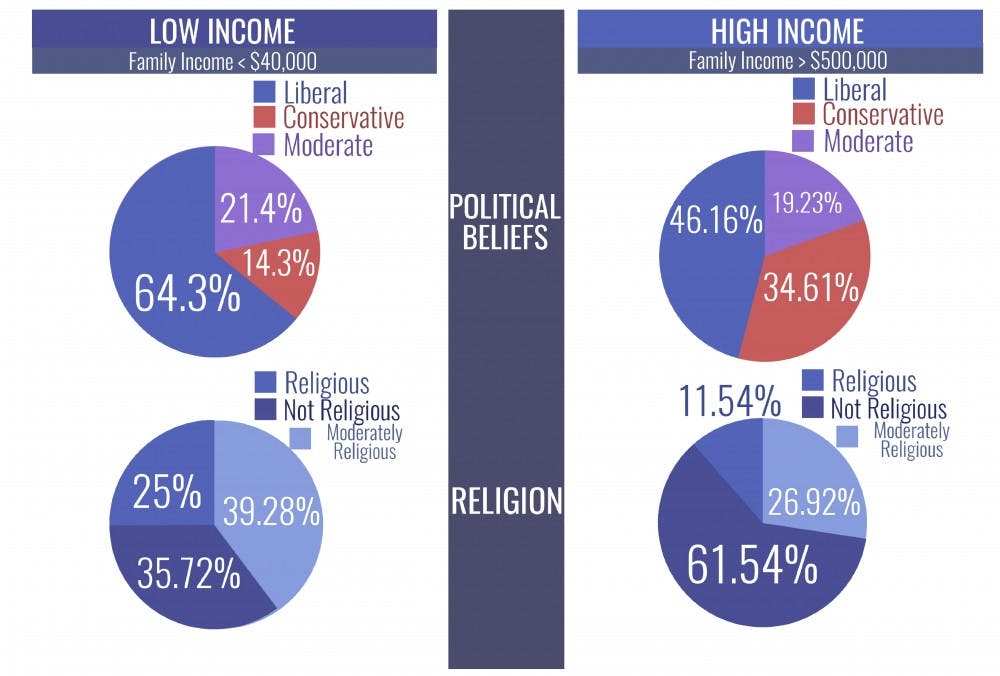Students from low-income families are more likely to be liberal and religious than students whose families are in the top one percent, according to a recent Chronicle survey.
This past summer, The Chronicle solicited responses to a survey for members of the Class of 2021, of which 281 students—about 16 percent of the class—responded to. Some of the questions centered on lifestyle, including drug use, political alignment and religion. Students in the bottom 40 percent of income—those whose families earn less than $40,000 annually—differed drastically on several lifestyle questions compared to students in the top one percent—those whose family income is more than $500,000 per year.
Nearly three-quarters of respondents have not had sex. A much larger percentage—nearly half—affirmed that they’ve consumed alcohol before college. A smaller portion have used drugs, at 18.8 percent. Whereas no low-income student reported obtaining a fake ID, about 17 percent of wealthy students reported getting one.
Political affiliation also saw some income-based division. About 64 percent of the low-income first-years identified as "liberal" or "very liberal," compared to about 46 percent of wealthy first-years. In fact, the proportion of wealthy respondents who identified as "conservative or very conservative" was more twice the proportion of low-income respondents—34.6 percent versus 14.3 percent. There were similar proportions of moderates in both camps.
Overall, only about three percent of respondents said that they were very conservative, with 30.1 percent identifying as very liberal. About 19 percent of students identified as moderate.
The bottom 40 percent students were more likely to have had alcohol than top one percent students, but less likely to have done drugs or had sex. Whereas about 68 percent of students with families earning less than $40,000 drank alcohol prior to entering college, only 40 percent of students with families earning more than $500,000 had had sex.
Religion was another category with sharp differences between these socioeconomic classes. One-quarter of first-years in the bottom 40 percent reported being "religious" or "very religious." However, only about 12 percent of first-years in the top one percent reported the same. The percentage of wealthy respondents that identified as "not very religious" or "not at all religious"—nearly 62 percent—was significantly greater than that of the low-income respondents—35.7 percent.
Overall, first-years are just as likely to identify as atheist and agnostic as they are to identify as Christian.
Whereas 17.5 percent and 16.6 percent of students identified as Protestant and Catholic, respectively, 14.5 percent and 19.6 percent identified as atheist and agnostic, respectively.
First-year respondents also showed a love of Apple products. More than two-thirds of respondents said they used Mac computers. An even larger percentage—82.5 percent—said that they used iPhones. The rest used an Android smartphone, at 16.7 percent, or Windows Phone, at 0.8 percent.
While on their iPhones, students spend the most time on Snapchat and Instagram, on average. The mean time spent on each app was 1.9 hours per day.
Get The Chronicle straight to your inbox
Signup for our weekly newsletter. Cancel at any time.
Class of 2019
Editor-in-chief 2017-18,
Local and national news department head 2016-17
Born in Hyderabad, India, Likhitha Butchireddygari moved to Baltimore at a young age. She is pursuing a Program II major entitled "Digital Democracy and Data" about the future of the American democracy.

